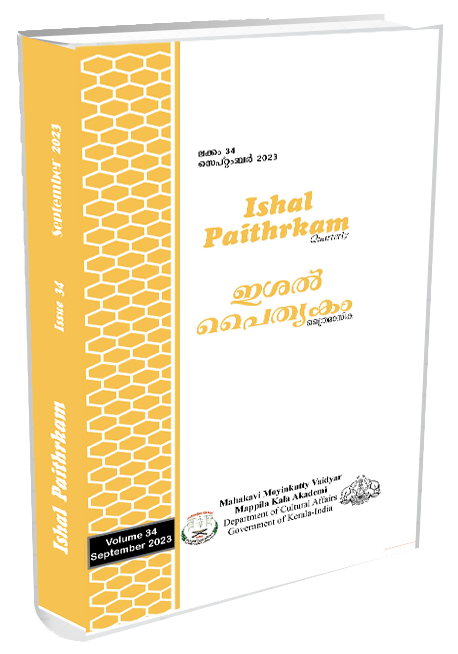Gauging Viewership Patterns and Engagement Levels of Malayalam Political Satire Shows
Keywords:
Political Satire, Credibility, Voting Pattern, Satire, Audience ViewAbstract
This study is aimed at exploring audience engagement with Malayalam television political satire shows through applying quantitative research methodology. The researchers have adopted purposive sampling technique and collected samples from the premises of Calicut University, Kerala, India. A total of 120 respondents participated in the study. The findings revealed that the audience’s frequency of watching political satire shows was positively correlated with their engagement with the content, particularly in terms of their attention to the political issues highlighted in the shows. The results also indicated that the audience’s demographic characteristics, including age, gender, and political affiliation, played a significant role in their engagement with political satire shows. Moreover, the study found that the audience’s media consumption patterns, such as their use of social media platforms, significantly influenced their engagement with political satire shows.
Downloads
References
Sebastian, T. (2021). The politics of comedy in Malayalam Cinema. Sexuality, Abjection and Queer Existence in Contemporary India, 84.
Sebastian, T. (2021). Laughter and abjection: The politics of comedy in Malayalam Cinema. In Sexuality, Abjection and Queer Existence in Contemporary India (pp. 112-130). Routledge India.
Karthika, C., & Vijayalakshmi, P. P. (2020). More than news: viewing habits of television news satires. Int. J. Adv. Sci. Technol, 29(03), 6963-6972.
Worcester, D. (2013). The art of satire. In The Art of Satire. Harvard University Press.
Highet, G. (2015). Anatomy of satire (Vol. 1353). Princeton University Press.
Condren, C. (2012). Satire and definition. Humor, 25(4), 375-399.
Menaka, G. & Sankar, G. (2018) A Study on Racism and Slavery in Mark Twain‘s The Adventures of Huckleberry Finn. Asian Journal of Language, Literature and Culture Studies, 1(2), pp.1-5.
Hill, M. R. (2013). Breaking boundaries| Developing a normative approach to political satire: A critical perspective. International Journal of Communication, 7, 14.
Foxwell-Norton, K., & Konkes, C. (2022). Is the Great Barrier Reef dead? Satire, death and environmental communication. Media International Australia, 184(1), 106-121.
Boukes, M., Boomgaarden, H. G., Moorman, M., & De Vreese, C. H. (2015). At odds: Laughing and thinking? The appreciation, processing, and persuasiveness of political satire. Journal of Communication, 65(5), 721-744.
Becker, A. B. (2020). Applying mass communication frameworks to study humor’s impact: advancing the study of political satire. Annals of the International Communication Association, 44(3), 273-288.
Baym, G. (2005). The Daily Show: Discursive integration and the reinvention of political journalism. Political communication, 22(3), 259-276.
Penney, J. (2020). ‘It’s So Hard Not to be Funny in This Situation’: Memes and Humor in US Youth Online Political Expression. Television & New Media, 21(8), 791-806.
Chandrasekhar, A. (2021). TV in Kerala: Vision, visibility, viability. In: Regional Language Television in India (pp. 207-218). Routledge India.
Parthan, S. (2022). We Are Better than the Women. Mimetic Desires: Impersonation and Guising across South Asia, 169.
Mini, D. S. (2015). The house of ill repute: Malayalee House, reality television and morality debates in contemporary Kerala. South Asian Popular Culture, 13(1), 47-59.
Usha Rani, N. (2016). Growth and development of regional television–Kannada. Journal of Media and Social Development, 6(1), 29-44.
Camilleri, M. A., & Falzon, L. (2021). Understanding motivations to use online streaming services: integrating the technology acceptance model (TAM) and the uses and gratifications theory (UGT). Spanish Journal of Marketing-ESIC, 25(2), 217-238.
Perloff, R. M. (1999). The third person effect: A critical review and synthesis. Media psychology, 1(4), 353-378.
Kim, Y., Kim, Y., & Zhou, S. (2017). Theoretical and methodological trends of agenda-setting theory: A thematic analysis of the last four decades of research. The agenda setting journal, 1(1), 5-22.
Oliver, S., Clarke-Jones, L., Rees, R., Milne, R., Buchanan, P., Gabbay, J., ...& Stein, K. (2004). Involving consumers in research and development agenda setting for the NHS: developing an evidence-based approach.
Young, D. G. (2008). The privileged role of the late-night joke: Exploring humor’s role in disrupting argument scrutiny. Media Psychology, 11(1), 119-142.
Kay. M. (2017). On with the Motley: Television Satire and
Discursive Integration in the Post-Stewart/Colbert
Era. Available at: https://core.ac.uk/download/pdf/268806756.pdf (Accessed: 2 January 2023).
Hmielowski, J. D., Holbert, R. L., & Lee, J. (2011). Predicting the consumption of political TV satire: Affinity for political humor, The Daily Show, and The Colbert Report. Communication monographs, 78(1), 96-114.
Becker, A. B. (2020). Applying mass communication frameworks to study humor’s impact: advancing the study of political satire. Annals of the International Communication Association, 44(3), 273-288.
Campbell, S., Greenwood, M., Prior, S., Shearer, T., Walkem, K., Young, S., ...& Walker, K. (2020). Purposive sampling: complex or simple? Research case examples. Journal of research in Nursing, 25(8), 652-661.
Niven, D., Lichter, S. R., &Amundson, D. (2003). The political content of late night comedy. Harvard International Journal of Press/Politics, 8(3), 118-133.
Klar, S., &Leeper, T. J. (2019). Identities and intersectionality: a case for Purposive sampling in Survey Experimental research. Experimental methods in survey research: Techniques that combine random sampling with random assignment, 419-433.
Lavis, J. N., Robertson, D., Woodside, J. M., McLeod, C. B., & Abelson, J. (2003). How can research organizations more effectively transfer research knowledge to decision makers?.The milbank quarterly, 81(2), 221-248
Downloads
Published
Issue
Section
License
Copyright (c) 2025 ISHAL PAITHRKAM

This work is licensed under a Creative Commons Attribution-NoDerivatives 4.0 International License.

